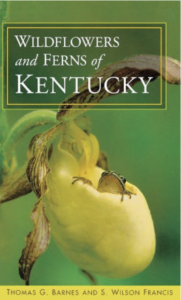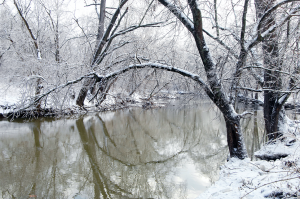Writer / Dan H. Jones, M.F., Ph.D., Chairman and CEO of The Parklands
In our temperate deciduous forest, when winter strikes, we tend to turn our attention away from nature and wait until spring returns to venture back out into The Parklands. However, there’s a lot happening outdoors in the winter, and there are a number of books that can help you explore, whether from the trail or the armchair.
If your interest is in getting out on the trail in winter or early spring, here are a few suggestions:
• The most unusual winter field guide I know of is Lauren Brown’s Weeds in Winter. It’s a masterful book, with nice sketches, of the most common weeds and flowering plants and their winter remnants. Many plants survive as hardy skeletons, with very distinctive and beautiful forms in their deceased flower heads and seed pods, until the following spring’s growth pushes them aside. While the book is out of print, there are many used, affordable copies available on Amazon.
 • Mary Wharton and Roger Barbour’s Trees and Shrubs of Kentucky is the best book you can buy if you want to improve your knowledge of trees, and they include images of both leaves and twigs, making it a great book for Field ID in any season, including winter. They also provide great information on species range in Kentucky (a real help with ID), and useful natural history overviews. Winter botany is challenging, but if you focus on bark, twigs and leaves left on the ground, it is a really fun way to learn trees, and the structure of a forest (the differing sizes, ages and growth forms of trees) is much more visible in winter, providing insightful study of the natural and cultural history of a given site. I’ve had this book for 35 years, and I still use it every year.
• Mary Wharton and Roger Barbour’s Trees and Shrubs of Kentucky is the best book you can buy if you want to improve your knowledge of trees, and they include images of both leaves and twigs, making it a great book for Field ID in any season, including winter. They also provide great information on species range in Kentucky (a real help with ID), and useful natural history overviews. Winter botany is challenging, but if you focus on bark, twigs and leaves left on the ground, it is a really fun way to learn trees, and the structure of a forest (the differing sizes, ages and growth forms of trees) is much more visible in winter, providing insightful study of the natural and cultural history of a given site. I’ve had this book for 35 years, and I still use it every year.
• My gift to myself this year is Donald and Lillian Stokes’ The Stokes Guide to Nature in Winter, with a goal of peeking beyond my own limited knowledge of The Parklands in winter. It’s out of print, but there are plenty of copies on Amazon.
• Finally, if you are a hold-out for early spring, and want to be ready when it arrives, Randy Seymour’s Wildflowers of Mammoth Cave National Park and Thomas G. Barnes and S. Francis Wilson’s Wildflowers and Ferns of Kentucky are the best books for wildflowers and both cover the flowers found in our area. Both are organized by season and flower color, making it very easy to identify species and also providing a great preparatory glimpse — in the section on spring flowers — of what awaits you when the sun finally climbs back across the Celestial Equator during the Spring Equinox and fires up our spring ephemerals, one of nature’s great shows.
For the armchair winter naturalist:
• If your preference is the armchair approach to winter nature, go no further than Bernd Heinrich’s A Year in the Maine Woods, or David George Haskell’s The Forest Unseen: A Year’s Watch in Nature. Heinrich spent years living in the woods of Maine and is the closest thing we have to a living Thoreau, as well as a wide-ranging and innovative ecologist. Haskell is a professor at Sewanee and presents the forest through a tiny patch of ground, showing that you can find something to see at any time and at any scale. Both walk you through the full year’s cycle, with great sections on the ecology of New England and Southern Appalachian Forests in the winter. By placing winter in context, you understand better the fact that life has not vanished, it’s simply gone to ground.
Finally, I highly recommend winter hiking. The cold embraces you and wakes you up, and nature highlights many of its secrets in the starkness of a winter landscape — from topography and morphology to weeds and seeds — that lie hidden through our lush summers. The light is beautiful and revealing, and you will learn another season of The Parklands’ magical landscapes.







Comments 1